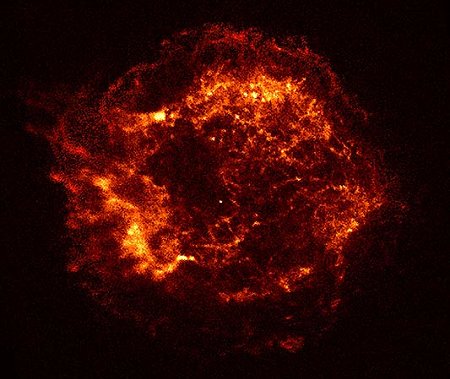'After the Chandra observatory was launched, we waited for the good news to come', he began. Suddenly from behind the room of the National Space Science and Technology Center in Huntsville, Alabama, one person interjected. 'Say it out loud to Martin, we're old!' Weisskopf replied: 'I already have a hearing aid', making the listener laugh.
 The first light picture of Chandra captures the rest of Cas A. supernovae (Photo: Chandra Science Center and NASA).
The first light picture of Chandra captures the rest of Cas A. supernovae (Photo: Chandra Science Center and NASA).
He and some of the telescope scientists in the audience were in retirement near the retirement age, but they were still pursuing intense new science with their great observatory. Weisskopf continued to describe their suspenseful state 10 years ago.'First we teamed for Chandra's internal jet system to put the device in orbit. Then we waited for the device to be ready, and continued to wait for a series of doors to open. In the end, we looked at the first picture and everyone co-formed 'Ahhh', our Telescope was active. '
It not only works, it has won and succeeded. This observatory is still ready to receive the next generation of astronomers and explorers on an amazing journey in the universe.
For the naked eye, and even for some types of telescopes, the night sky looked completely quiet. But the universe is a place with violence and chaos, full of supernova explosions, millions of degrees of intergalactic clouds, and river disks of broken material orbiting black holes. Chandra is very special with the ability to observe this volatile world and shed light on many scientific mysteries.
 The Chandra image gave scientists the first observation of X-rays from Mars. (Photo: NASA and Chandra Science Center).
The Chandra image gave scientists the first observation of X-rays from Mars. (Photo: NASA and Chandra Science Center).
And it all started when the rest of the supernova 'Cas A' was Chandra's first official light photo. Scientists deduced that the material went into space from the explosion crashed into the surrounding material at a rate of 10 million miles per hour. These collisions create intense shock waves, like a loud sound explosion, creating a massive 50 million degree gas mass that releases X-rays. Heavy elements in the hot air create X-rays in those specific energy level. Chandra can accurately measure these X-rays and show the ratio of each element present. With this information astronomers can explore how elements necessary for life are created and spread throughout the galaxy due to stellar explosions.
In short, Chandra has helped to assert that we ourselves are the material.
Weisskopf said: 'Iron in our blood comes from some stars that exploded many billions of years ago.'
After only two months in space, Chandra captured a photograph of another supernova explosion, the Crab Nebula, and for the first time showed a bright ring containing a high energy element surrounding its nucleus.
 A picture of Hubble-Chandra's Combined Crab Nebula. (Photo: Chandra Science Center and NASA )
A picture of Hubble-Chandra's Combined Crab Nebula. (Photo: Chandra Science Center and NASA )
Combined with observations from the Hubble Space Telescope, Chandra's data gave clues to how the rotation of neutron stars at the center of the Crab Nebula provides energy for the nebula. The nebula still shines 1000 years after the explosion.
Chandra also teaches astronomers about quasars, binary stars, 'matter-eating' black holes - this list is becoming more 'mysterious and curious'. This Chandra image shows the central part of the Milky Way. The white area near the center of the image is the home of a supermassive black hole.
 Photograph of the central Milky Way galaxy of Chandra X-ray Observatory.
Photograph of the central Milky Way galaxy of Chandra X-ray Observatory.
Chandra has discovered black holes everywhere in the universe, and some of the telescope's best discoveries are made in the vicinity of black holes.
In addition, Chandra helped bring dark matter out of shelter, laying the foundations for progress in the field of dark energy research, and giving clues to the evolution and development of the universe over time. time, and even teach us many things about the planet's nearby planets.
Weisskopf explains: 'X-rays and particles from the Sun are crashing into Mars's atmosphere. We can learn some things about that atmosphere by observing the structure of the image done by Chandra. '
X-ray astronomy was born in 1960. Uhuru, the first satellite to serve X-ray astronomy, was launched into orbit in 1970 and mapped several hundred light sources. Chandra is hundreds of times more sensitive than Uhuru and has so far performed more than 9500 observations.
According to program manager Keith Hefner, 'We are very confident about the observatory's performance. With recent extensions, Chandra can operate until 2019 and even more. '
Is there still more to observe?
Weisskopf said: 'For a long time we will observe the universe. And we have enthusiastic young scientists participating in this research group. They were only born when we first started thinking about Chandra. They have some great ideas - and importantly they don't have to wear hearing aids. '
 Van Allen's belt and evidence that the Apollo 11 mission to the Moon was myth
Van Allen's belt and evidence that the Apollo 11 mission to the Moon was myth The levels of civilization in the universe (Kardashev scale)
The levels of civilization in the universe (Kardashev scale) Today Mars, the sun and the Earth are aligned
Today Mars, the sun and the Earth are aligned The Amazon owner announced a secret plan to build a space base for thousands of people
The Amazon owner announced a secret plan to build a space base for thousands of people